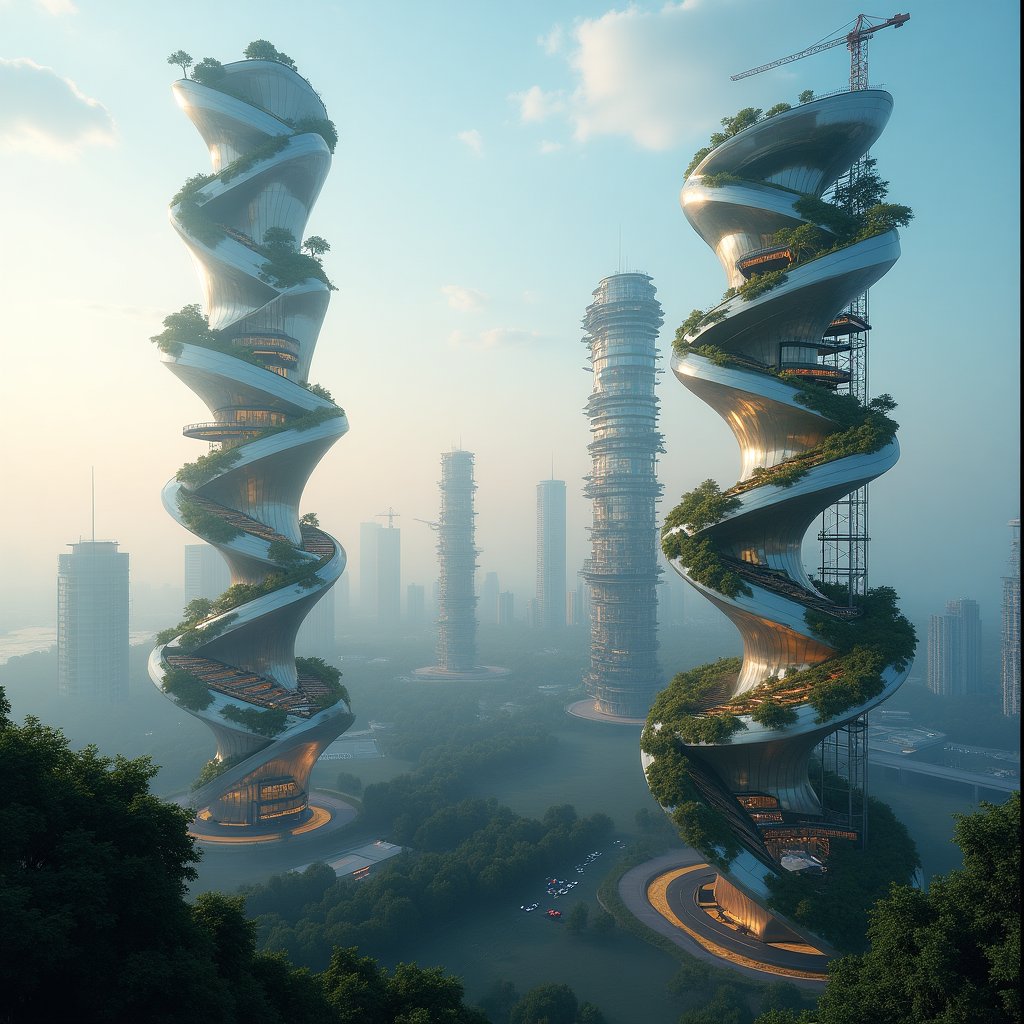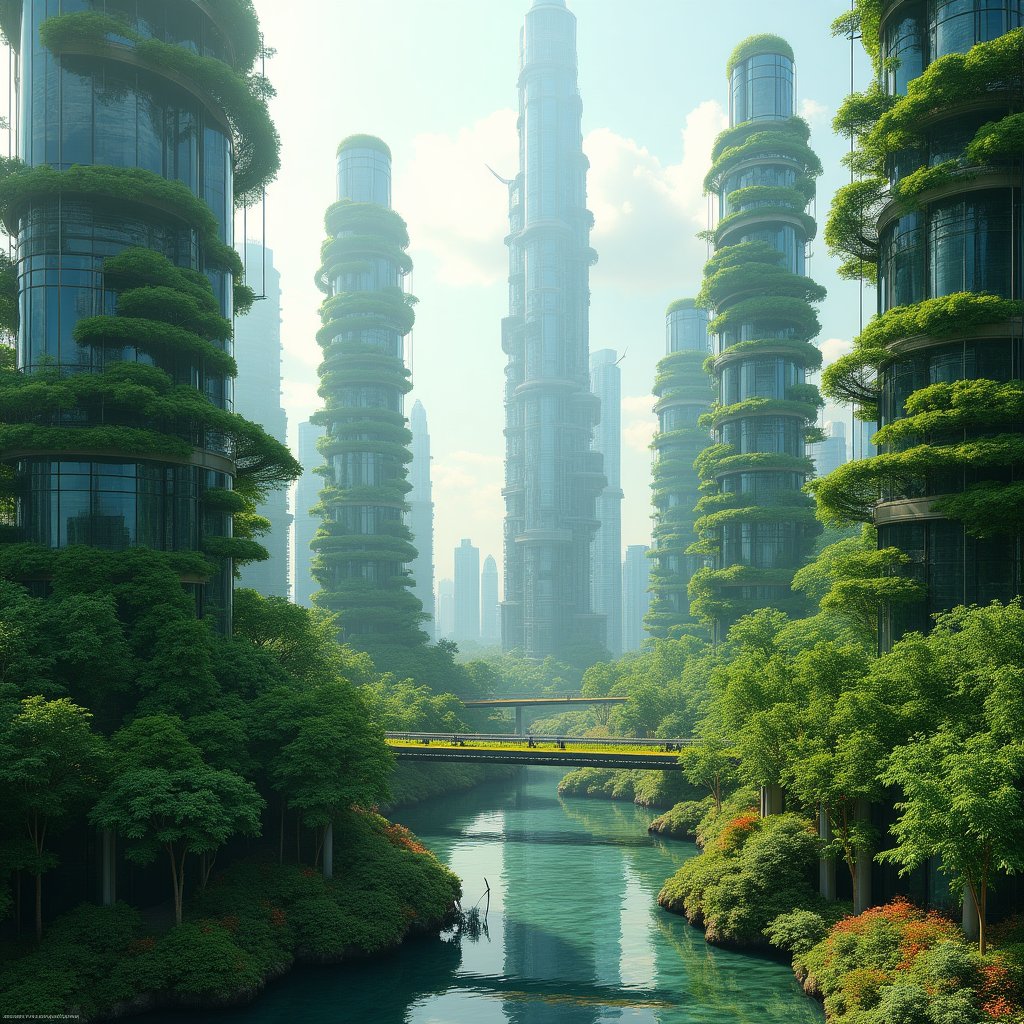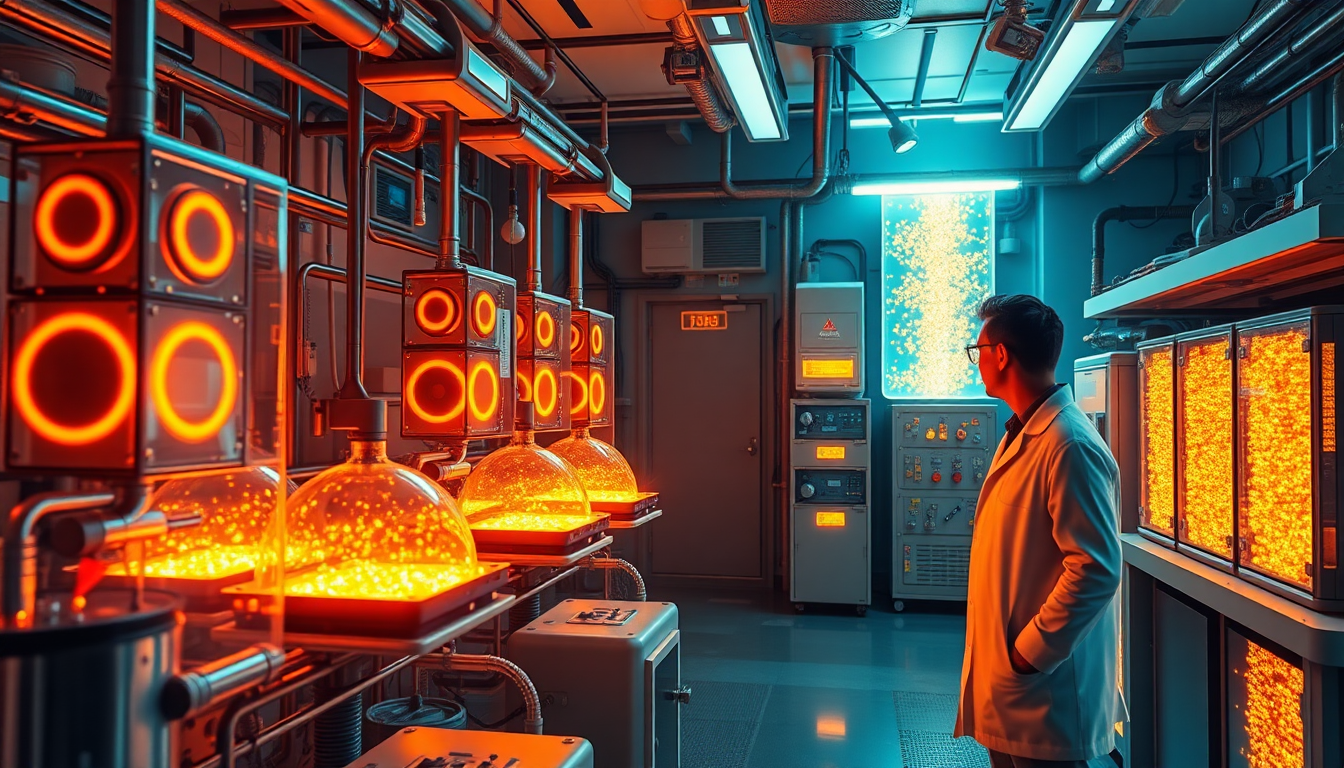What if the limits of architecture were no longer dictated by gravity or the constraints of human imagination? What if the future of design weren’t sketched on a blueprint by hand, but instead generated by an algorithm—one capable of conjuring forms no human would dare dream up? This sci-fi-sounding scenario is no longer a flight of fancy; it’s the reality unfolding as artificial intelligence disrupts and reinvents how we build the world around us. In the realm of skyscraper design, the “impossible” is becoming less a hard boundary and more of a creative frontier.
Architects and visionaries from Zaha Hadid to theorists like Yuval Noah Harari, and construction futurists like Patrik Schumacher, have long talked about blending technology with aesthetics to address the design challenges of the modern world. But the dawn of AI has pushed this conversation into overdrive. Using tools like generative design algorithms, machine learning, and parametric modeling, AI doesn’t just contribute; it dominates the design process. Curved twisting towers inspired by the DNA double helix are born in seconds. Entire cityscapes can be pre-visualized for sustainability and efficiency with just a few keystrokes. And the results are dazzling creations that blend art, physics, and computational precision to an extent once thought impossible.
At the heart of this intersection of technology and imagination lies a bigger question: What makes a building possible? Is it structural integrity, aesthetic appeal, or the ability to stand the test of time? AI forces us to reevaluate not only what buildings can look like but also how they function and serve both their occupants and the cities that surround them. By mimicking the organic systems of nature, predicting structural loads better than humans, and innovating new techniques in construction, AI is forging a primordial shift that has left experts in awe—and skeptics scrambling to keep up.
As we’ll explore, AI’s potential to redefine skyscrapers and megastructures stretches beyond mere aesthetics. It is tackling climate resilience, economy of resources, urban planning, and even reimagining our concept of what a building is. From shimmering facades that adapt to light like a chameleon’s skin to all-out floating megastructures that suspend disbelief (and a lot of steel), this fusion between architecture and machine is taking us somewhere we’ve never been before: toward a world where gravity can no longer hold us down.
AI-designed skyscrapers use machine learning to generate gravity-defying designs, optimize material use, and create climate-resilient structures previously impossible for human architects.
1. The AI Revolution in Architectural Design
1.1 Overview of AI in Design
Artificial Intelligence in architectural design is nothing short of revolutionary. What once took months of human calculations and revisions now takes mere hours—or even minutes—thanks to the immense computational power of AI-based tools. Generative design, for instance, is upending traditional workflows by allowing algorithms to explore thousands of variations of a blueprint almost instantly. The software doesn’t just suggest one solution; it maps out an entire landscape of possibilities based on predefined parameters like wind resistance, material efficiency, and even cultural aesthetics. In this brave new world, creativity isn’t bounded by what we’ve already tried; it’s fueled by endless experimentation.
Take the example of the innovative projects from Zaha Hadid Architects, such as the Al Wasl Plaza Dome in Dubai. By integrating AI with parametric workflows, the team achieved a tensile masterpiece of light and fluidity that wouldn’t have been feasible using traditional design approaches. Similarly, firms like Autodesk are pushing the limits of generative design, while startups like Spacemaker use AI to solve urban planning dilemmas impossible for manual calculations.
1.2 AI-Inspired Creativity
Artists often say inspiration comes from nature, and now AI is taking this lesson quite literally. Many of today’s most exciting AI-driven design concepts are based on patterns, forms, and structures found in the natural world. Whether it’s the spiral of a seashell, the twisting tendrils of ivy, or even the strengths and weaknesses within a termite mound, AI mirrors the biomimetic ingenuity of evolution itself. The result? Skyscrapers that not only look bizarrely exotic but also perform more efficiently than rigid traditional designs.
Think about twisting towers like the Turning Torso in Sweden or Shanghai Tower—the latter partially inspired by biomimetic ideas of wind resistance to cut energy costs. These designs reveal the potential of AI tools to mimic natural geometries. Software like Rhinoceros 3D and Grasshopper leverages AI’s brute force computational power to play with shapes until something extraordinary emerges: structures that defy engineering norms while serving legitimate purposes.
1.3 Balancing Art and Engineering
Herein lies the genius of AI as a creative partner: while it thrives on unbounded creativity, it must also account for real-world feasibility. For example, a flowing, gravity-defying tower envisioned by AI may produce awe at first glance, but once engineers take over, structural loads need recalibration, material strength must be analyzed, and real-world criteria like cost and safety factor in.
This is where collaborative software closes the gap. Engineers and architects can pair AI-generated designs with real-time simulations to test for gravitational tolerances, wind loading, and even seismic resilience before committing to a final blueprint. Tools such as Bentley Systems’ Generative Components ensure structures as daring as the “The Gherkin” in London are widely acclaimed masterpieces—not just hollow dreams resting on implausible calculations.
AI isn’t replacing the artistry of human architects; it’s amplifying it by challenging limitations that once seemed immutable. It lets designers think big, push boundaries, and redefine modern beauty. Imagine standing atop a twisting skyscraper designed entirely by code, gazing down upon a reshaped urban landscape. With AI, even these lofty heights don’t seem so out of reach anymore.
2. Structural Resilience: AI’s Blueprint for Defying Gravity
2.1 Structural Optimization through Machine Learning
What if skyscrapers no longer conformed to traditional vertical forms but instead leaned, twisted, or even gave the illusion of floating mid-air? This seemingly futuristic vision is being made possible by the precision of AI’s structural optimization algorithms. Machine learning tools are redefining how architects distribute structural loads across high-rises, enabling them to build architecture that challenges the status quo—and gravity itself. Generative design platforms like Autodesk’s Generative Design allow engineers to simulate and analyze billions of potential configurations to find designs that stay standing while pushing aesthetic and structural boundaries.
Take the example of the Marina Bay Sands in Singapore. While not fully AI-designed, its gravity-defying SkyPark—a cantilevered rooftop the length of three football fields—was made structurally feasible thanks to computational modeling. Moving forward, AI-enhanced design tools offer the ability to safely scale this approach to entirely new dimensions, such as structures with asymmetric bases or dual axes of suspension.
2.2 Redefining Building Materials Through AI Predictions
The challenge with designing “impossible” buildings isn’t simply their form—it’s also finding materials capable of withstanding the stresses placed on them. By using predictive AI, architects are unlocking cutting-edge materials that are both lightweight and hyper-resilient. For example, researchers at MIT are leveraging AI algorithms to develop graphene-based composites that are 10x stronger than steel but weigh a fraction as much.
Generative AI tools can even simulate years’ worth of wear and tear in virtual environments, helping identify which materials will perform best in extreme conditions. For instance, in earthquake-prone cities like Tokyo or Los Angeles, AI can optimize buildings using shape memory alloys or flexible concrete mixtures that absorb seismic shocks without cracking. Projects like The Shard in London already highlight how material innovation can unlock record-breaking heights, and with AI, the bar is set to rise even higher.
2.3 Earthquake and Extreme Weather Resilience
One of AI’s most promising capabilities lies in designing skyscrapers that are not only astonishing in appearance but structurally resilient enough to withstand natural disasters. AI systems today can predict how a building will react to severe pressure from hurricanes, tremors, and even floods by analyzing vast datasets of historical and simulated disaster scenarios.
Consider the AI-driven advancements behind Taipei 101’s tuned mass damper. This 660-ton device swings gently to counter distributed forces during typhoons and earthquakes. While the damper’s creation predates AI’s current capabilities, next-generation AI tools make it possible to design even more intricate mechanisms capable of adapting in real-time to any geological or meteorological contingency. Imagine a skyscraper that “dances” with the wind or quakes, adjusting itself akin to how a skyscraper-sized willow tree might sway amidst a storm. It’s not just science fiction—it’s our emerging architectural reality.
3. Parametric Design: Precision in Motion
3.1 The Rise of Parametric Modeling
Parametric design is the secret sauce that allows architects to mold skyscrapers into impossibly unique shapes while ensuring they remain functional and feasible. Tools like Rhino’s Grasshopper enable designers to define sophisticated mathematical relationships between a building’s curves, dimensions, and functions. This results in forms that continuously evolve until they meet both aesthetic standards and engineering requirements.
The iconic Gherkin in London—a parametric marvel designed by Foster + Partners—is a testament to the power of this technology. Its curved, bullet-shaped design not only revolutionized London’s skyline but also reduces wind deflection, minimizing any impact on taller structures nearby. AI-enhanced parametric tools take this kind of ingenuity further, dynamically adapting designs to meet ecological and functional requirements in real time.
3.2 AI and Climate Responsiveness
Gone are the days when skyscrapers were static monoliths of glass and steel. Today, AI-driven parametric designs are creating buildings that interact intuitively with their environment. Dynamic façades now adjust themselves to optimize energy efficiency depending on factors like sunlight, wind direction, and thermal conditions. Imagine windows that “breathe” based on CO2 levels or entire walls that fold like origami to block excessive sunlight.
One exceptional example is Studio Libeskind’s Adapt Skin, a parametric high-rise project designed to harvest solar energy while autonomously adjusting panels for maximum heat regulation. As AI integrates with smart city infrastructures, these features become indispensable—shaping buildings equipped to adapt seamlessly to fluctuating weather patterns and energy demands in cities like Dubai, where immense temperature changes occur daily.
3.3 Efficiency: Less is More via Algorithmic Refinement
At its core, parametric design powered by AI is about doing more with less. AI simulations allow buildings to reach new heights with a fraction of traditional material use by making every structural element serve multiple functions. In conventional construction, such optimization is nearly impossible without costly trial-and-error methods.
For instance, imagine a skyscraper in New York that collects rainwater through strategically arranged spires or maximizes interior space by hollowing out sections that don’t contribute to the building’s stability. In a powerful example of AI-guided efficiency, the Beijing National Stadium, affectionately referred to as the Bird’s Nest, features lightweight steel designs informed by parametric algorithms, minimizing waste while maximizing visual drama.
By fostering a design philosophy rooted in algorithmic refinement, AI ensures that future megastructures will not only take up minimal environmental resources but also redefine how sustainability is expressed through architecture.
4. AI-Powered Construction Techniques
4.1 Robotics Meets Construction
Welcome to the era where construction sites are starting to look more like science fiction movie sets than traditional job sites. AI-powered robots are transforming how we build skyscrapers, bringing precision, efficiency, and capabilities that human labor alone could never achieve. Companies like Boston Dynamics are already supplying robots capable of navigating construction terrain, working autonomously, and even assembling complex structures with surgical accuracy.
Picture a swarm of autonomous drones working in unison like ants, laying bricks and welding steel beams securely into place hundreds of feet above the ground. Add to the mix quadrupedal robots equipped with advanced AI vision systems like Spot from Boston Dynamics inspecting progress or carrying heavy tools. These robotic construction assistants can safely and efficiently handle hazardous tasks in conditions humans can’t or shouldn’t endure.
One notable example of this technology in action is the use of drones in constructing skyscrapers in Dubai, where they’ve already been piloted to assemble experimental structures. AI’s ability to orchestrate these machines ensures not only unprecedented safety but also adherence to exacting engineering standards, inch by inch.
4.2 Modular Construction Redefined
Imagine skyscrapers built like puzzle pieces snapped together. That’s modular construction in a nutshell, and AI is taking it to the next level. Pre-manufactured components, often prefab modules, are designed and optimized using generative AI algorithms, which refine layout configurations for the least material wastage and maximum strength. This dramatically reduces construction time and cost, while still delivering groundbreaking design.
Factories equipped with AI-driven robotics produce these modules at an industrial scale with near-zero margin for error. Assembly on-site, managed by AI systems, becomes simple, faster, and safer. Noteworthy AI-guided modular projects include Skyline Tower in NYC, which employed prefab modules to climb its creative heights in record time.
Some benefits of modular construction further refined by AI include:
- Speed: Construction timelines are shortened by up to 50%.
- Cost-efficiency: Fewer delays and reduced labor costs.
- Eco-friendliness: Material waste is minimized thanks to AI optimization.
- Customizability: Modules are created according to climate, seismic activity, and design needs.
4.3 3D Printing at Skyscraper Scale
Want to print a skyscraper? Thanks to AI and breakthroughs in large-scale 3D printing, we’re fast approaching this possibility. Concrete, metal, and even carbon-fiber elements can now be “printed” layer by layer using AI-guided 3D printers. Imagine machines like ICON, a leader in construction-scale 3D printing, producing fully printable sections of high-rises in controlled environments.
This technology is particularly beneficial for disaster-prone or resource-scarce regions. By using algorithms to determine the optimal layout and material density, AI allows printing mechanisms to fabricate structurally robust sections with a fraction of the material required by traditional techniques.
Consider a recent 3D-printing marvel: a 30-foot high pavilion in Beijing made entirely of printed resin. Now scale that concept hundreds of times over—and you begin to see the potential of this technology in skyscraper construction. However, the real secret sauce is AI’s ability to predict potential flaws in printing, suggest real-time adjustments, and deliver seamless execution.
5. Future Skyscrapers for Future Cities
5.1 AI-Informed Urban Planning
Building a skyscraper is just one piece of the puzzle. Cities must accommodate a complex ecosystem of humans, transportation, energy grids, and environmental factors. Artificial intelligence is revolutionizing urban planning by integrating skyscrapers seamlessly into the fabric of future cities, ensuring they function as much as they impress. Companies such as Arcadis and innovations by research teams like those at the Massachusetts Institute of Technology (MIT) are leading the way.
Imagine a skyscraper in 2050 that dynamically coordinates with nearby buildings to share resources like water and renewable energy or reports real-time structural and climatic data to city planners. AI goes beyond physical structure and integrates with urban life itself, helping manage congestion, zoning, and population densities.
Key urban planning tools leveraged by AI include:
| AI Tool | Function | Example |
|---|---|---|
| Predictive Traffic Models | Optimize traffic flow around high-rises. | Google’s Waze integrations for urban designs. |
| Energy Distribution Algorithms | Balance renewable power in building clusters. | Work by NREL. |
| Environmental Impact Models | Minimize ecological costs of urban construction. | AI projects by World Bank. |
5.2 Self-Sustaining Megastructures
The skyscraper of the future isn’t just tall—it’s fully self-sufficient. AI is driving a revolution in sustainable architecture, designing buildings capable of generating their energy, recycling their water, and even growing food. A famous concept, the “vertical farm”, envisions high-rises layered with algae bio-reactors for power and hydroponic farms for food production.
One real-world example is Bogotá’s Edificio Santalaia, a high-rise covered in greenery responsible for rainwater capture and passive cooling. But AI has bigger ideas. By analyzing building usage data, weather models, and resource availability in real-time, it dynamically adjusts systems for maximum self-sustainability. These skyscrapers don’t just reduce their carbon footprint—they generate carbon credits for their cities.
5.3 Vertical Communities of the Future
The tallest buildings won’t just house offices. AI shows us a future where skyscrapers become entire cities within themselves. Picture a high-rise designed to cater to its residents' every need: vertical transport systems powered by smart AI, floors dedicated to education, healthcare, recreation, and even farms.
The concept of vertical urbanism is already being prototyped in models like NEOM in Saudi Arabia—where AI simulates entire ecosystems of “living” buildings. The promise is clear: better space utilization in crowded urban centers and reduced reliance on sprawling suburbs.
In this brave new world of urban design, residents might visit suspended swimming pools, enjoy smart gyms that adapt workouts on the fly, or live in apartments that auto-adjust lighting, temperature, and oxygen levels—all thanks to interconnected AI systems.
6. Challenges and Ethical Considerations
6.1 Ethical Dilemmas in AI-Fueled Creativity
Can we put a price on human creativity, or is creativity in architecture interchangeable with machine-driven innovation? As Zaha Hadid Architects and firms like Foster + Partners increasingly adopt AI to generate awe-inspiring structures, skeptics argue that the heart of design is at risk of being lost. While AI opens up an unprecedented well of inspiration, it also raises a contentious question: are we dehumanizing creativity itself? Removing architects, engineers, or even day laborers from key portions of the process might lead to sterile, uninspired end results somewhere down the line. Would we fall out of love with the cities we build if they became too "robotic"?
Then there's the question of economic displacement. Highly trained professionals in architecture and construction might face redundancy as AI-powered tools tackle their roles. Sure, these technologies promise efficiency. But part of the dilemma is asking whether society is properly equipped to retrain displaced workers and redistribute opportunities—or if people will simply be cast aside in the name of progress.
6.2 Sustainability vs. Spectacle
Let’s face it: skyscrapers are synonymous with ambition, making them irresistible symbols of progress for mega-cities trying to claim global attention. Yet, this obsession with standing out often comes at the expense of sustainability. How do we reconcile bold forms that defy gravity and capture imaginations with the urgent realities of climate change? Even AI’s relentless optimization can’t always offset the carbon cost of dramatic skyscraper designs.
Think about the Burj Khalifa in Dubai, an engineering marvel but also a stark energy guzzler. Yes, machines can help us engineer more efficient designs—they might recommend green energy grids or algae bio-farms integrated into façades—but does pouring endless resources into these behemoths make sense in regions already teetering on resource scarcity? The growing critique is simple: bold designs should add to sustainability, not just "wow" factor.
Meanwhile, AI may inadvertently propagate unsustainable development in high-demand urban zones, failing to consider nuanced cultural or environmental dynamics. The Grand Prize Question: Can architectural AI learn to prioritize purpose over spectacle, or is it fundamentally geared by ambition alone?
6.3 Regulatory Questions in AI Construction
The legal and regulatory frameworks surrounding AI-designed architecture are still nascent at best. For governments looking to balance technological acceleration with public safety, the task is tricky. If an AI system designs a skyscraper and an unforeseen structural flaw surfaces, who assumes liability? Is it the software creator, the building contractor, or the commissioning client?
Moreover, advancements in AI construction could outpace the ability of local building codes to adapt. Cities like New York City, renowned for its skyscrapers, may suddenly find that existing zoning laws and materials standards clash with AI-driven advancements. Even emerging AI tools like large-scale 3D printing, powered by robotics firms like Boston Dynamics, present challenges for safety inspectors who must assess technologies so cutting-edge they haven’t even appeared in civil engineering handbooks yet.
Beyond this lies a potentially more chilling question: As AI increasingly designs and potentially oversees autonomous construction systems, where’s the human emotional or moral check to ask “is this safe?” Will cities become scapes of experimental risk in place of calculated engineering?
Conclusion
The future of skyscraper design is no longer constrained by human limits. Artificial intelligence is revolutionizing what’s possible in architecture, blazing a trail into realms once limited to science fiction. From engineering impossible forms that stretch the imagination to creating energy-efficient megastructures that harmonize with their environment, AI isn’t just changing how we build—it’s changing why, and even where, we build.
But innovation rarely comes without trade-offs. As we marvel at twisting parametric towers and AI-optimized vertical cities, we’re forced to reckon with thorny questions about ethics, accountability, and sustainability. Will skyscrapers become soulless products of a machine’s algorithm, or will we find ways to harness AI to deepen rather than erode humanity’s connection to the built environment? Can skyscrapers of the future be both inspiring and balanced—a source of technological wonder that also meets the sustainability demands of our shrinking planet?
The skyscrapers of tomorrow won’t just reflect technological ability; they’ll reflect human values. Every design decision foregrounds the delicate interplay of ambition and responsibility. As dreamers, doers, and designers, are we ready to commit to—and defend—a future where our buildings echo our environmental and cultural ethos just as loudly as they do our engineering genius?
What’s certain is this: humanity stands at the threshold of reimagining its urban skyline. Whether those colossal AI-driven structures hang in the air like a city-wide chandelier or blend gracefully into an eco-conscious ecosystem, their success will be defined not by the machines that crafted them, but by the wisdom of those who chose to build them.
So, what do you think? Should we dive headfirst into this brave new AI-powered era of architecture, or are there risks we haven’t yet accounted for? Let us know in the comments below!
And if you want to stay ahead of the curve in technology, design, and innovation, don’t forget to subscribe to our newsletter for a chance to become a permanent resident of iNthacity: the "Shining City on the Web." Like, share, and join the conversation—we can’t wait to hear your take!
FAQ: Breaking Down AI-Designed Skyscrapers
If you’ve ever gazed at a futuristic skyscraper concept and wondered, “How is that even possible?”, you’re not alone. Artificial intelligence (AI) is revolutionizing how we design, build, and think about architecture. Below, we answer some of the most pressing questions about AI-driven skyscrapers, pushing architectural boundaries and reimagining our skylines.
1. What Exactly Does AI Do in Architectural Design?
AI doesn’t just crunch numbers—it’s an innovation powerhouse. It analyzes massive datasets, runs simulations, and generates designs based on specific goals like maximizing wind resistance or minimizing resource use. AI-driven tools like Autodesk’s generative design platform or NVIDIA’s simulation engines are empowering architects to test out ideas that would take humans years to conceptualize.
An easy way to think of this: AI is like a collaborator, not a replacement. It presents human architects with thousands of possibilities, often inspired by forms found in nature, such as the biomimetic principles used in the design of twisting skyscrapers that mimic DNA helices or termite mounds.
Want proof in action? The breathtaking Al Wasl Plaza in Dubai combines innovative structural engineering and AI-assisted design to create enormous tensile domes, reflecting architectural ingenuity once thought impossible.
2. Can AI-Designed Buildings Actually Be Built?
Yes, AI-designed buildings are no longer just “concept art”—they’re becoming reality. Many AI-generated designs are already under construction or fully realized. Think of The Gherkin in London, conceptualized with parametric modeling and made possible through meticulous material optimization.
- The Capital Gate Tower in Abu Dhabi: Its 18-degree lean was achieved through sophisticated structural algorithms.
- Future-forward skyscrapers like those envisioned by Zaha Hadid Architects challenge gravity itself using AI’s predictive modeling tools.
3. How Does AI Help With Sustainability in Skyscraper Design?
Sustainability is a cornerstone of AI-driven architecture. Using AI, architects can simulate and adjust a building’s solar exposure, airflow, and thermal dynamics to reduce energy waste. Many eco-skyscrapers are designed with adaptive facades powered by AI—think windowpanes that tilt automatically to optimize sunlight or retract during storms.
Take the Bahrain World Trade Center. Embedded wind turbines generate renewable energy, a concept tested meticulously with AI simulations. These aren’t just trendy eco-fads—they’re fundamental to building resilient vertical cities. Furthermore, designers use AI to integrate algae bioreactors into skyscrapers for oxygen production. Talk about buildings being nature’s roommates!
4. Are Gravity-Defying Designs Structurally Sound?
It seems counterintuitive, but AI is more precise than traditional human calculations when it comes to load-bearing structures. Complex designs that lean or twist often use AI tools like ANSYS for finite element analysis, which pinpoints how forces like gravity, wind, and vibrations distribute through every molecule of a tower’s frame.
| AI Tool | Purpose | Example in Use |
|---|---|---|
| ANSYS | Structural simulation | Shanghai Tower |
| Autodesk Generative Design | Blueprint optimization | Al Wasl Plaza |
5. Are Robots And 3D Printing Changing Skyscraper Construction?
Absolutely. Robots and large-scale 3D printers, guided by AI, are transforming construction. Picture fleets of drones flying in unison to assemble skyscraper frameworks. Companies like Boston Dynamics are pioneering robotic assistants that don’t just reduce human error—they slash construction timelines by weeks or even months.
And 3D printing? It’s not just for tiny plastic trinkets anymore. Firms like Apis Cor are working on large-scale printers for high-rise buildings. Imagine printing out intricate lattice structures straight from a digital AI model to reality. Not futuristic sci-fi—it's happening now.
6. Will Architects Be Replaced by AI?
The question isn’t “will AI replace architects” but rather “how will AI work alongside architects?” While AI takes care of tedious calculations and ideations, humans still bring the soul to architecture. Think of AI as the sous-chef—it preps the ingredients, but you’re the one presenting the final dish.
For firms like Foster + Partners, AI expedites tedious tasks like blueprint refinements while freeing designers to focus on creativity and storytelling. It’s a partnership, not a rivalry—a marriage of data and dreams.
7. What Ethical Challenges Come With AI-Designed Skyscrapers?
While AI unlocks incredible potential, it also raises tough questions. Who is liable if an AI-designed structure fails—the programmer or the architect? How do we prevent overreliance on tech at the cost of human craft?
Architectural ethics must evolve alongside tools. Groups like the American Institute of Architects (AIA) advocate for ethical AI use, ensuring sustainable growth while addressing concerns about labor displacement and diversity in design philosophies. The debate is as complex as the engineering—but crucial to the future of architecture.
Do you have more questions about the role of AI in transforming our cityscapes? Leave your thoughts in the comments below to keep the conversation alive!
Wait! There's more...check out our gripping short story that continues the journey: A Man of String and Steel
Disclaimer: This article may contain affiliate links. If you click on these links and make a purchase, we may receive a commission at no additional cost to you. Our recommendations and reviews are always independent and objective, aiming to provide you with the best information and resources.
Get Exclusive Stories, Photos, Art & Offers - Subscribe Today!

























1 comment